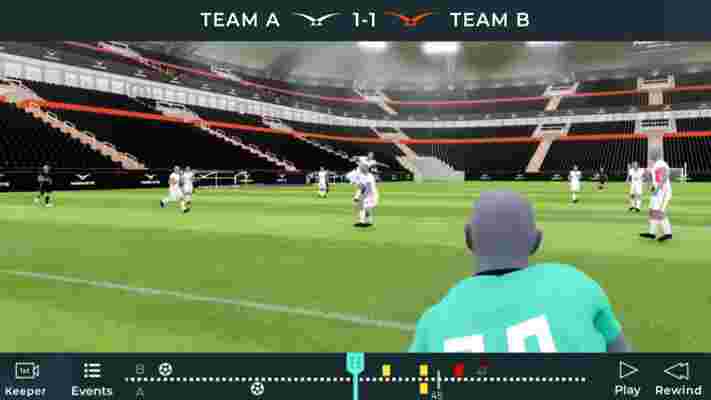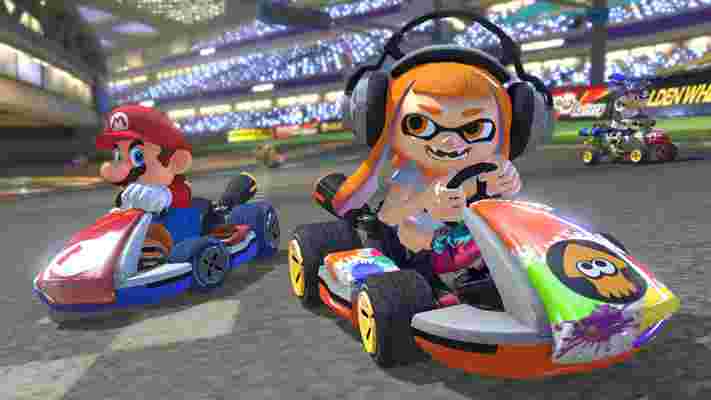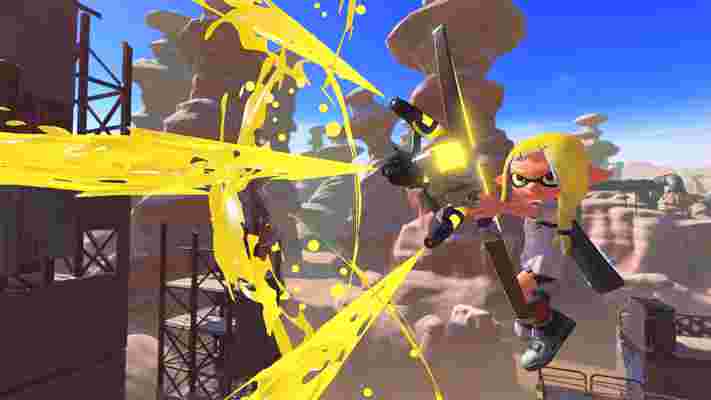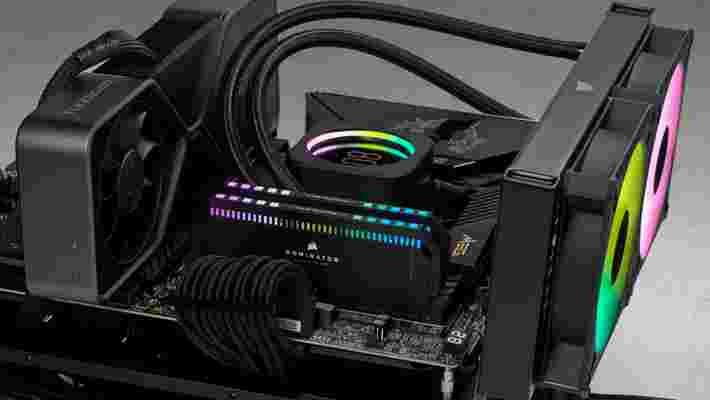Sony's Hawk-Eye division has already brought goal-line technology to soccer, but now a next-gen version called Skeletrack could finally end the sport's VAR offside controversies.
In a demo of Hawk-Eye's new Skeletrack tech at CES 2022 , Sony showed how the 'virtual recreation' of on-pitch action could soon be used to automatically judge offside decisions with similar accuracy to its current goal-line technology.
VAR, or Video Assistant Referees, have become a mainstay in soccer leagues and tournaments around the world, with the English Premier League adopting video replays for incidents including potential penalties and red cards from 2020.
But the technology's application to the offside rule, which stipulates that an attacking player cannot be beyond the last defender when receiving the ball, has been controversial. This is because it's still reliant on human assistant referees viewing video footage, with the aid of one-pixel-thick lines to help them make the offside decision.
Skeletrack is potentially a big improvement on the current VAR process because it combines optical tracking technology with AI tech that can analyze video capture in real time.
During the demo, Sony said that "Skeletrack analyzes the ball position as well as the players' positions and postures in real-time with AI, then visualizes the game through virtual recreation". It then showed how this might be applied to a VAR offside decision, with 3D models of the players (and their relevant body parts) being automatically analyzed in real-time to see whether an offside call should be made.
Sony didn't reveal any more details about when this next-gen Hawk-Eye tech could come to VAR, simply saying that "Skeletrack can advance the fairness and transparency of decision making across sport". But if it works as well the demos suggest, we could see it appear in soccer leagues and tournaments in the next few years.
While offside decisions are one big use case for Skeletrack, Sony was also keen to highlight at CES 2022 that the tech is suitable for "unlimited use cases", including gamifying the watching experience for fans. By effectively giving armchair viewers a virtual camera, it could let fans see the action from the goalkeeper's perspective, or give them "a seat in the stands in one of the best stadiums in the world".
The first stadium to be recreated virtually will be Manchester City's Etihad stadium, with Sony using CES 2022 to highlight a partnership with the club that it first announced in November 2021. This will apparently deliver an online 'metaverse' for fans to interact with in VR, including a digital version of Manchester City's home ground.
Analysis: another step towards AI referees

On-pitch referees will always bring an essential human element to managing soccer matches, but their decisions are becoming increasingly automated thanks to the accuracy of real-time video analysis – and Hawk-Eye's new Skeletrack tech is another step down that path.
Hawk-Eye, which Sony acquired in 2011, has become the world's most popular soccer goal-line technology system, but offside decisions have proved a tougher nut for technology to crack due to the number of moving parts involved: the ball, plus the fast movement of attackers and defenders.
While there are still obstacles to a 100% accurate offside system, including determining the precise moment when a ball is struck, Skeletrack does look like a promising advance over the current VAR process.
In England's Premier League, which is the most-watched sports league in the world, offside decisions are still determined by the manual positioning of virtual lines over video replays, which are taken from five video cameras around the stadium.
But this process was so controversial that two big changes were made for the current 2021/2022 season. Firstly, for marginal offsides, thicker lines are now applied over the system's default one-pixel lines, with incidents where those lines overlap now being deemed onside. Also, to avoid showing the clunky decision-making process to TV viewers, only a final image confirming the decision is now broadcast.
The big advance with Skeletrack is the inclusion of real-time AI analysis, which is apparently advanced enough to automatically make a call on sporting decisions as complex as soccer's offside rule. The tech is already being used by analysts in the USA's NBA league and Italy's Serie A soccer league, but football fans and long-suffering assistant referees will hope to see it also taking the uncertainty out of offside decisions soon.
Why the Nintendo Switch Online Expansion Pack is now a no-brainer
After a more than controversial start, Nintendo just redeemed the Switch Online Expansion Pack in one fell swoop. Beginning March 18, subscribers will be able to access all of Mario Kart 8 Deluxe’s upcoming DLC at no additional cost, which will add 48 new tracks to the evergreen title until the end of 2023.
If you ever needed an incentive to subscribe, Mario Kart 8 Deluxe DLC is most definitely it. Not only does the Booster Course Pass ensure that Nintendo’s most popular Switch title will keep people racing for many more years to come, but when you consider that the upcoming DLC costs $24.99 / £22.49 on its own, then the $49.99 / £34.99 / AU$59.95 for a 12-month subscription to Nintendo’s premium service suddenly looks rather reasonable.
It helps that Mario Kart 8 Deluxe is one of the best online multiplayer experiences on the platform, too. Many Switch owners (myself included) probably only subscribe to Nintendo’s online service in the first place so they can continue racing against other players across the globe. And if that’s the case, you might as well buy the Expansion Pack and get Mario Kart 8 Deluxe’s DLC as part of the deal – you’ll be paying $44.98 / £40.48 if you choose to buy the DLC separately and subscribe to Nintendo Switch Online anyway. In fact, that means UK Switch subscribers could actually end up paying £5 more than they might need to if they don’t pick up the Expansion Pack.
Show me your moves

Of course, the Mario Kart 8 Deluxe Booster Course Pass isn’t the only perk of subscribing to the Nintendo Switch Online Expansion Pack. To my surprise, Nintendo has steadily added more N64 and Sega Genesis titles to the service, instead of drip-feeding games at its usual glacial pace. Paper Mario and Banjo-Kazooie have already arrived, and The Legend of Zelda: Majora’s Mask is coming to the N64 library this month. On Sega Genesis, we saw the additions of Altered Beast, ToeJam & Earl, Dynamite Headdy, Sword of Vermillion, and Thunder Force II. Not a bad start, and efforts from dataminers show that many more titles are likely on the way.
But that’s not all: the Nintendo Switch Online + Expansion Pack also includes free access to the Animal Crossing: New Horizons Happy Home Paradise DLC. That means DLC for the two best-selling Switch games now resides on Nintendo’s premium subscription service, and again, Happy Home Paradise costs $24.99 / £22.49, 50% the price of a 12-month subscription to the Expansion Pack.
That’s a huge audience that Nintendo can tap into, many of whom will no doubt find the prospect of racing on brand new tracks and playing a whole new Animal Crossing expansion incredibly appealing. The N64 and Genesis library of games should always have been the cherry on top of the Expansion Pack service, not the entire cake, and it appears that Nintendo has thankfully realized this.
Nintendo’s plan for the Switch Online Expansion Pack has suddenly become crystal clear, then. It can no longer be viewed as just a paywall that cordons off classic titles. Instead, it has the potential to be a service that houses DLC for all the best Nintendo Switch games , titles that many of us are still playing today.
It’s time to play online

However, if Nintendo’s recent Direct showcase taught us anything, it’s that the company is also taking online play extremely seriously (at long last). Yes, the Switch will fundamentally never be able to deliver the type of social experience that PS5 and Xbox Series X can with party chats, instant messaging, and sharing content. But we’re seeing a positive trend of Switch titles implementing online play in a notable way, rather than as an afterthought.
In 2022 alone, we’ll see Splatoon 3 , Mario Strikers Battle League , Nintendo Switch Sports , Advance Wars 1 + 2 Re-boot Camp , No Man’s Sky, Disney Speedstorm, SD Gundam Battle Alliance, MLB: The Show 22, Portal 2, and many more all include online multiplayer, which is rather unprecedented to see on a Nintendo console. Especially as not even three years ago, we were lamenting the omission of online multiplayer in Super Mario Party , which at the time should have been a given.
It’s clear that Nintendo is not only focusing on making its Switch Online Expansion Pack service a tantalizing proposition but that it also wants to ensure more people are playing online in general.
Expand your possibilities

The Nintendo Switch Online Expansion Pack was initially criticized for being too expensive and for not offering enough content, a complaint that was absolutely fair at the time. The jump from $19.99 / £17.99 / AU$29.95 for a 12-month subscription to $49.99 / £34.99 / AU$59.95 just to access N64 and Sega Genesis game was ridiculous, honestly, but now it seems like a really good deal that only promises to get better.
If Nintendo continues to put delectable DLC onto the Expansion Pack, the value proposition will only grow more apparent. Perhaps it could, eventually, put the Super Smash Bros. Ultimate DLC on there, or whatever downloadable content comes to Splatoon 3? Either way, Nintendo’s using the power of its excellent IPs to drive subscribers to its online services instead of banking on people’s rose-tinted glasses and nostalgia. And that’s exactly how it should be.
Corsair’s DDR5 RAM is fast, flashy, and easy to control
We’re at a point of generational leaps in computers. It was a hop and a skip as we went from PCIe 3.0 to 4.0 and then right on to 5.0 for incredible bandwidth going to connected peripherals and storage drives. Now, we’re making the jump from DDR4 memory to DDR5, and Corsair is here to provide some blisteringly fast memory that’s easy to manage.
When it comes to memory, few brands have been as good at showing off just how far the envelope can be pushed. Corsair has a long history of venturing out ahead of the pack with high-speed memory that outstrips the JEDEC standards — the baseline specifications on a wide variety of memory you’d find on store shelves — by leaps and bounds.
In the first DDR memory generation, Corsair hit DDR-400 before JEDEC made it an official spec. Corsair hit DDR2-1066 while JEDEC capped at DDR2-800, and similarly, Corsair pushed DDR3-3000, nearly doubling JEDEC’s DDR3-1600 standard.
It was almost the same story with DDR4 memory, as Corsair was able to throw down DDR4-5133 to simply trounce the DDR4-2666 standard established by JEDEC.
This history of going well beyond “standard” is continuing into the DDR5 generation. Corsair is already cruising ahead with DDR5-6400 — speeds we wouldn’t have dreamt of without exotic cooling just a few years ago — while JEDEC is just at DDR5-4800. A 33% boost is not to be overlooked when it’s the speed of the memory supplying your CPU with all the data it needs to operate. This is especially handy for APUs (Accelerated Processing Unit), which can benefit from all the extra memory speeds and bandwidth to feed the on-board graphics processing.
Not only is Corsair delivering that supremely fast memory, but Corsair iCUE makes it incredibly simple to manage that memory.
There will be some applications where you may want to run your system with the RAM running at full bore with clock frequencies maxed out, such as in games where the faster memory can improve framerates, while creative applications may benefit from tighter timings on the memory while enjoying improved stability.
With Corsair iCUE’s XMP manager, you can create and save two XMP (Extreme Memory Profiles) profiles to your memory modules, making it easy to set up and switch between them. No more muddling around in your system BIOS for hours tediously creating XMP profiles that might not even work.

Of course, a computer that’s decked out with Corsair’s high-performance DDR5 memory deserves to be as flashy as it is speedy, and it can be with Corsair iCUE lighting controls.
Using the same iCUE software you used to control the performance of your RAM, you can customize the lighting on your memory modules down to the finest details.
You’ll get control over individual LEDs, can create lighting layers, and can build out profiles to easily switch the style up. If you’ve got other Corsair RGB-lit peripherals or hardware inside your system, iCUE can let you sync them all up for a dazzling light show.
Corsair iCUE also supports software and game integrations, the RGB lighting in your system can change color and brightness to reflect things happening in your games.
To max out your next build’s speed and style, check out Corsair’s DDR5 memory here .